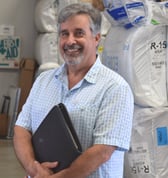 As both a green and custom home builder, Eddie Fort of PD & M Contractors has a client base that is affluent and knowledgeable about energy efficiency. Fort, winner of the 2015 EarthCraft “Home of the Year,” award, builds shorefront properties in Smith Mountain Lake, Virginia, near the geographic center of the state and adjacent to Lynchburg. At a price point of $750,000 and above, Eddie works closely with his clients to deliver a dream home that includes all the “bells and whistles” you expect with a custom home, which typically means “high end” everything. But for PD & M, delivering energy efficiency and quality doesn’t have to come at a super premium price. In fact, the company insists on spending its client’s money wisely. One area where they achieve that goal is through using hybrid insulation systems – particularly “flash and batt.”
As both a green and custom home builder, Eddie Fort of PD & M Contractors has a client base that is affluent and knowledgeable about energy efficiency. Fort, winner of the 2015 EarthCraft “Home of the Year,” award, builds shorefront properties in Smith Mountain Lake, Virginia, near the geographic center of the state and adjacent to Lynchburg. At a price point of $750,000 and above, Eddie works closely with his clients to deliver a dream home that includes all the “bells and whistles” you expect with a custom home, which typically means “high end” everything. But for PD & M, delivering energy efficiency and quality doesn’t have to come at a super premium price. In fact, the company insists on spending its client’s money wisely. One area where they achieve that goal is through using hybrid insulation systems – particularly “flash and batt.”
Matching Big Dreams and Smart Spending
While lacking the sexiness of home automation systems or quartz counter tops, insulation often comes up in initial conversations with customers. “When we discuss the specifics of each project, insulation is one of the items that we typically cover. Roughly 75 percent of the time, our customers are interested in spray foam, but once we discuss costs and benefits, they agree with us regarding our recommended approach using the flash and batt technique,” he explained.
Consumers get much of their insulation education from celebrity contractors on HGTV. Fort offered this assessment of the shifting opinions: “Those TV conversations happen without any mention of the cost of the product, and even customers who can afford it are receptive to a smarter way to spend their dollars.”
Fort’s company typically uses R-19 batt insulation plus ½ inch of closed-cell spray foam (the “flash” layer) for air sealing the cavity -- not for a significant contribution to R-value. “This approach helps keep costs down and provides a high-performance wall system,” he notes. “We’re also starting to use batts with structural insulated sheathing of R-3+ as that seems to get us great performance.”
The combination of the foam and the batt insulation ensures a tight thermal envelope, provided it’s properly installed, which means that quality assurance is a must.
Quality Assurance Process
Fort advised that builders who want to deliver properly insulated homes select the right contractor and work closely with the contractor to get a quality job. “We’re delivering homes that meet HERS 40 – 50 targets” Fort said. “We’re able to get there in large part because we selected the right insulation contractor, clearly articulated the expectation of grade one installation and have a quality control process built in.”
Each new project for PD& M comes with a customary set of meetings with various contractors, including the insulation contractor, Toler Insulating. “I meet with Paul [Newman] VP at Toler on the job site for each new home. We then go over any potential issues that we may have and discuss methodology to address them,” Fort said. “Once the job is completed, I go over the work to ensure it is properly installed. We also have our HERS rater and the building inspector examine it as well.”
Fort’s insistence on grade one quality isn’t something he believes he should pay a premium for — and he doesn’t. “I articulate it as a goal and our contractor is on board with that. We have several people, including the installer, their supervisor, myself, our HERS rater and the building inspector all reviewing the job.”
Fort often hears about the challenges of getting quality batt insulation jobs, but disagrees that getting grade one is difficult. “We expect grade one and we usually get it,” he notes. “For us, and I think all builders, education is a must. Builders need to learn what a grade one installation job actually is and pay attention to the details to ensure that they are getting just that,” he added. “We’ve been using the same insulation contractor for many years and we each know what the expectations are.”
Because PD& M builds to the former EarthCraft (now Viridiant) standard, which emphasizes sustainable, energy efficient and healthy homes, his clients can expect lower utility bills, enhanced indoor air quality and increased comfort. Homes built to the standard also typically command a higher resale price than similar homes built to minimum code requirements.
“Even with custom homes, people still want to spend their money wisely,” Fort said. “We explore every option to deliver a high performance, high quality home that will meet our client’s expectations and our insulation and air sealing approach allows us to do that.”





